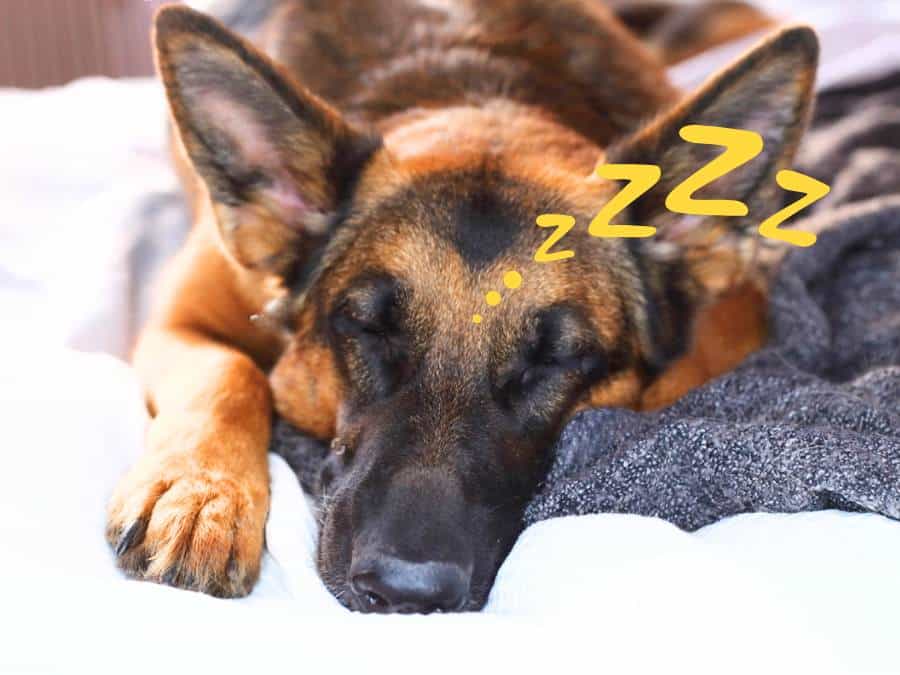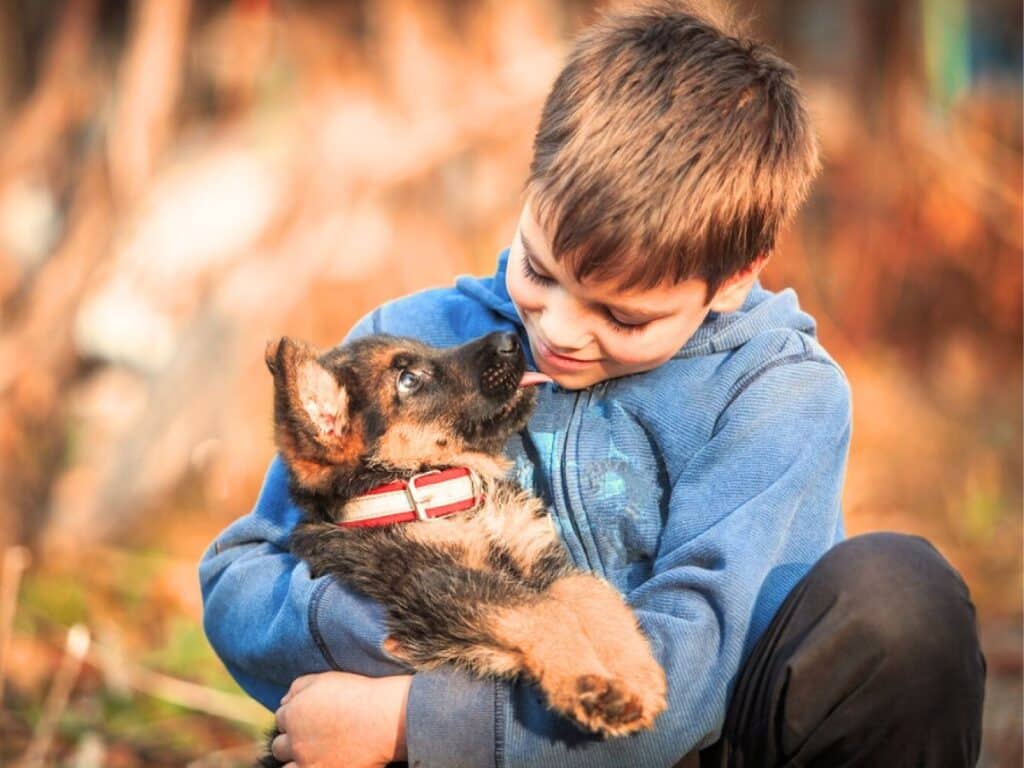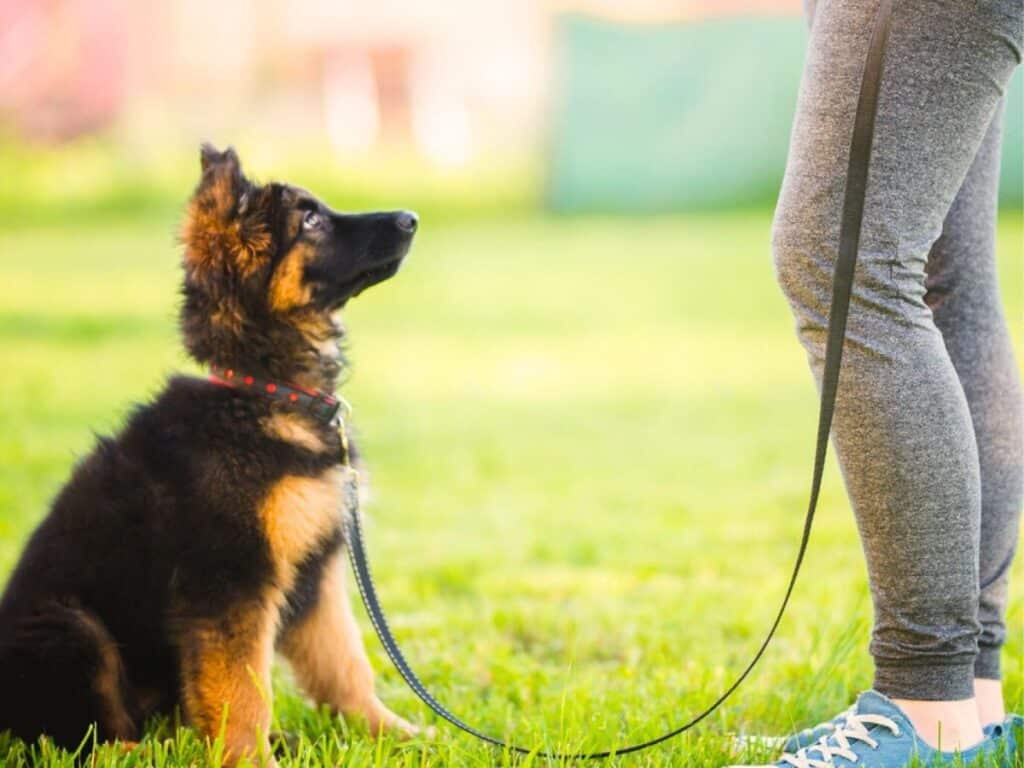Wondering how to tire out your German Shepherd without endless walks and playing fetch? I’ve got you covered!
There was a time when, due to my studies, I couldn’t dedicate an hour to exercising and walking my German Shepherd, Rocky.
So I started experimenting with different exercises, (which did not include walking, jogging, playing fetch, etc.) trying to figure out which ones came close to tiring him out in the shortest amount of time, and luckily I found a few.
* This post contains affiliate links. Thank you! *
How To Tire Out a German Shepherd
German Shepherds are intelligent dogs with a history deeply rooted in herding livestock, requiring both mental stimulation and physical activity daily. Without adequate exercise, they can become bored or even develop behavioral issues.
So here are 7 quick ways to tire out your German Shepherd:
1. Flirt pole
A flirt pole typically consists of a long, flexible pole with a rope or string attached to one end. At the other end of the rope, there’s usually a lure such as a plush toy, squeaky toy, or a bundle of fabric.

German Shepherds have a strong prey drive and they love to chase moving objects, which is why the flirt pole is so engaging for them.
When you wave the pole around, the lure mimics prey-like movements, triggering your dog’s prey drive and encouraging them to chase after it. Moreover, it’s great because it’s an activity where your dog does all the work.
Chasing the lure on the flirt pole requires your dog to run, jump, and make quick movements, providing them with an excellent cardiovascular workout. This kind of high-intensity exercise is great for burning off excess energy, particularly for hyperactive German Shepherds with a lot of pent-up energy.
You can either make your flirt pole or buy one online. Here is a flirt pole I found on Amazon that is perfect for medium-large dogs.
Chasing Tails Flirt Pole

2. Chasing bubbles
Chasing bubbles is yet another simple but effective way to provide exercise and mental stimulation for your dog.

Chasing bubbles requires minimal equipment—all you need is a bottle of bubble solution and a bubble wand.
Seeing bubbles floating through the air triggers your German Shepherd’s prey drive and instinct to chase. This instinctual response makes chasing bubbles an exciting and engaging activity for your dog.
Chasing bubbles encourages your dog to run, jump, and make quick movements as they try to catch or pop the bubbles. This provides them with a great workout, helping to burn off excess energy and keep them physically fit.
Make sure you use a bubble mixture that won’t hurt your dog’s eyes using glycerin and water.
You can also find bubble solutions at most toy stores or online. Here are two safe and scented bubble solutions I found on Amazon:
If you want your dog to be entertained and active while you’re busy doing something else, you can use an automatic bubble blower.

Buy Automatic Bubble Blower on Amazon
3. Feed your dog using a slow feeder or a food toy
Besides helping to control your dog’s eating speed, a slow feeder is another excellent way to manage your German Shepherd’s energy levels.

Instead of scarfing down that first meal of the day in a matter of seconds, a slow feeder will help create a challenge for your dog making them have to work and think as they enjoy their food.
A slow feeder is a specially designed food bowl or puzzle toy that makes it more challenging for your dog to access their food. It typically has obstacles, ridges, or compartments that force your dog to slow down and work for their food rather than gobbling it up quickly.
For dogs prone to boredom or anxiety, slow feeders can be a great way to provide mental enrichment and alleviate stress. By focusing on the task of getting their food out of the feeder, dogs are less likely to engage in destructive behaviors or exhibit signs of anxiety or frustration.
For this, you can use:
- Kong toy and fill it with treats, peanut butter, or other tasty fillings, and encourage your dog to work to get the treats out.
- Slow Feeder dog bowl which makes your dog work to get to their food, the effort will tire the dog out and keep them from gobbling down their meal at the same time.
KONG Wobbler – Slow Feeder Toy

Buy KONG Slow Feeder on Amazon
Slow Feeder Dog Bowl

Buy Slow Feeder Dog Bowl on Amazon
Generally, my dog took a deep nap immediately after eating from a KONG toy.
And, if your dog is particularly clever, get the following food puzzle that makes them solve problems to release their food.
Hide N’ Slide Interactive Treat Puzzle Dog Toy

Buy this Puzzle Dog Toy on Amazon
4. Frisbee
Frisbee involves a lot of running and jumping, which are activities that most German Shepherds enjoy. The constant movement and sprinting back and forth to catch the frisbee can quickly wear out your dog’s energy reserves.

Frisbee isn’t just about physical exertion; it also requires mental focus and coordination. Your German Shepherd must track the trajectory of the frisbee, anticipate its movements, and time their jumps accurately to catch it. This mental engagement can be as tiring as the physical activity itself.
Use a soft, lightweight frisbee specifically designed for dogs to prevent injury. Avoid playing on hard surfaces like concrete or asphalt, as this can be tough on your dog’s joints.
You can check out this soft rubber frisbee that I found on Amazon.

5. Tug-of-War
Tug of war is a physically demanding activity that engages your dog’s muscles and cardiovascular system. As they pull on the toy, they use their legs, shoulders, and neck muscles, providing them with a full-body workout.

This kind of physical exertion can tire out your dog quickly, especially if they’re putting in a lot of effort to win the game.
When playing tug just remember to follow one rule: the game stops if your dog’s teeth touch your skin. Puppies who haven’t learned bite inhibition will struggle with this rule.
If you want to save your hands from those sharp teeth remember to teach your puppy not to bite before attempting tug.
6. A quick training session
Training sessions require your dog’s full attention, engaging their mental faculties. Whether it’s practicing basic obedience commands like sit, stay, or come, or teaching new tricks or behaviors, your dog needs to focus on you and the task at hand.
This mental engagement can be tiring for them, especially if the training involves problem-solving or learning new tasks.
Depending on the type of training you’re doing, it can also involve physical activity for your dog.
For example, you can place tape across a doorway to create jumps for your dog to go over or limbo bars for him to go under.
Training and learning new tricks and commands gives dogs purpose, and a sense of accomplishment and challenges them mentally which, again, is a great way to tire out your high-energy dog.
RELATED: 30 German Shepherd Training Commands & Free PDF
7. Play hide-and-seek with treats
Similar to the traditional game played with humans, playing hide-and-seek with treats involves hiding treats around your home or yard and encouraging your dog to find them.
You can start by showing your German Shepherd a treat and then hiding it in a relatively easy-to-find location to help them understand the game.
According to AKC, searching for hidden treats engages your dog’s sense of smell, which is highly developed and important for their mental stimulation.
While hide-and-seek with treats primarily focuses on mental stimulation, it can also involve some physical activity depending on how active your dog is during the search.
Dogs may have to move around, explore different areas, and even climb or reach for treats hidden in higher or more challenging locations. This gentle physical activity can contribute to your dog’s overall tiredness, especially if they’re engaged in a prolonged search.
How much exercise does a German Shepherd need daily?
German Shepherds require at least 1-2 hours of physical activity each day to stay healthy and happy. This can include walks, runs, playtime, and mental stimulation exercises.
The exercise needs of a German Shepherd can vary based on their age. Here’s a breakdown of how much and what kind of activities/exercises German Shepherds typically require at different stages of their lives:

Puppies (Up to 6 Months):
- Short, frequent walks (around 10-15 minutes per walk) on soft surfaces to protect their developing joints.
- Indoor play sessions to encourage socialization, exploration, and light physical activity.
Adolescents (6 Months to 2 Years):
- Longer walks (around 30-45 minutes per walk) or multiple shorter walks each day.
- Engage in interactive play sessions such as fetch or tug-of-war to burn off excess energy.
Young Adults (2 to 4 Years):
- Daily exercise sessions totaling 1 to 2 hours, including brisk walks, jogging, hiking, or engaging in canine sports like agility or obedience training.
- Incorporate off-leash play in a secure, fenced area to allow your dog to run and explore freely.
- Provide mentally stimulating activities such as puzzle toys, scent games, or training exercises to keep their minds sharp.
Adults (4 to 8 Years):
- Similar to young adults, aim for 1 to 2 hours of exercise per day, which can include a combination of walks, runs, playtime, and training sessions.
Seniors (8 Years and Older):
- Shorter, low-impact activities such as gentle walks, swimming, or moderate play sessions.
- Monitor your senior dog closely during exercise and adjust the intensity and duration as needed to prevent overexertion or discomfort.
RELATED: How Much Exercise Does a German Shepherd Need?
Final Remarks
In conclusion, keeping your German Shepherd mentally and physically stimulated is essential for their overall well-being and happiness. By incorporating a variety of engaging activities into their daily routine, you can help tire out your dog in a positive and enjoyable way. Whether it’s through interactive games like tug of war or hide-and-seek with treats, outdoor adventures like frisbee or flirt pole, or mental challenges like puzzle toys or training sessions, there are countless ways to keep your German Shepherd entertained and fulfilled.
FURTHER READING:




